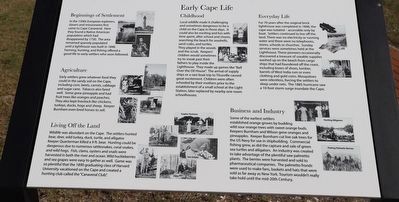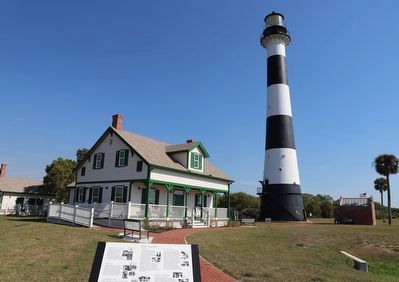Cape Canaveral in Brevard County, Florida — The American South (South Atlantic)
Early Cape Life
Beginnings of Settlement
In the 1500s European explorers, slavers and missionaries first came to Cape Canaveral. Here they found a Native American population which had disappeared by 1730. The area remained sparsely populated until a lighthouse was built in 1848. Farming, hunting, and fishing offered a good life to early settlers who soon followed.
Agriculture
Early settlers grew whatever food they could in the sandy soil on the Cape, including corn, beets, carrots, cabbage and sugar cane Tobacco also fared well. Some grew pineapple and had fruit trees like oranges and peaches. They also kept livestock like chickens, turkeys, ducks, hogs and sheep. Keeper Burnham even bred horses to sell.
Living Off the Land
Wildlife was abundant on the Cape. The settlers hunted bear, deer, wild turkey, duck, turtle, and alligator. Keeper Quarterman killed a 9 ft. bear. Hunting could be dangerous due to numerous rattlesnakes, coral snakes, and wild hogs. Fish, clams, oysters and snails were harvested in both the river and ocean. Wild huckleberries and sea grapes were easy to gather as well. Game was so plentiful that the 1890 graduating class of Harvard University vacationed on the Cape and created a hunting club called the "Canaveral Club”.
Childhood
Local wildlife made it challenging and sometimes dangerous to be a child on the Cape in those days. It could also be exciting and fun with time spent, after school and chores, searching the beach for seashells, sand crabs, and turtles. They played in the woods and the scrub. Keepers’ children would sometimes try to sneak past their fathers to play inside the Lighthouse. They made up games like "Ball Over the Oil House”. The arrival of supply ships or a rare boat trip to Titusville caused great excitement. Children were often schooled by their mothers prior to the establishment of a small school at the Light Station, later replaced by nearby one-room schoolhouses.
Everyday Life
For 70 years after the original brick lighthouse was completed in 1848, the cape was isolated - accessible only by boat. Settlers continued to live off the land. There was no electricity or running water and there were no telephones stores, schools or churches. Sunday services were sometimes held at the Lighthouse. These pioneers occasionally discovered a treasure of useable supplies washed up on the beach from cargo ships that had foundered off the coast, including boxes of shoes, lumber, barrels of West India rum or even clothing and gold coins. Mosquitoes were relentless, forcing the settlers to sleep under nets. The 1885 hurricane saw a 10-foot storm surge inundate the Cape.
Business and Industry
Some of the earliest settlers established orange groves by budding wild sour orange trees with sweet orange buds. Keepers Burnham and Wilson grew oranges and pineapples. Keeper Burnham cut live oak trees for the US Navy for use in shipbuilding. Commercial fishing grew, as did the capture and sale of green sea turtles and alligators. An industry was created to take advantage of the plentiful saw palmetto plants. The berries were harvested and sold to pharmaceutical companies. The palmetto fronds were used to make fans, baskets and hats that were sold as far away as New York. Tourism wouldn't really take hold until the mid-20th Century.
Erected by Florida Lighthouse Association.
Topics. This historical marker is listed in these topic lists: Agriculture • Industry & Commerce • Native Americans • Settlements & Settlers • Waterways & Vessels. A significant historical year for this entry is 1848.
Location. 28° 27.601′ N, 80° 32.631′ W. Marker is in Cape Canaveral, Florida, in Brevard County. Marker is on Lighthouse Road north of Control Tower Road, on the left when traveling north. Touch for map. Marker is in this post office area: Cape Canaveral FL 32920, United States of America. Touch for directions.
Other nearby markers. At least 8 other markers are within 2 miles of this marker, measured as the crow flies. Cape Canaveral Light Station (a few steps from this marker); Cape Canaveral Lighthouse (within shouting distance of this marker); Cape Canaveral's Native Americans (within shouting distance of this marker); a different marker also named Cape Canaveral Lighthouse (about 400 feet away, measured in a direct line); Launch Site of America's First Satellite, Explorer I / The Space Race Begins (approx. 2 miles away); Cape Canaveral Air Force Station (approx. 2 miles away); First United States Space Launch (approx. 2 miles away); Launch Complex 26 (approx. 2 miles away). Touch for a list and map of all markers in Cape Canaveral.
Also see . . . Cape Canaveral Lighthouse. (Submitted on March 5, 2023.)
Credits. This page was last revised on March 5, 2023. It was originally submitted on March 5, 2023, by Dave W of Co, Colorado. This page has been viewed 80 times since then and 7 times this year. Photos: 1, 2. submitted on March 5, 2023, by Dave W of Co, Colorado. • Bernard Fisher was the editor who published this page.

